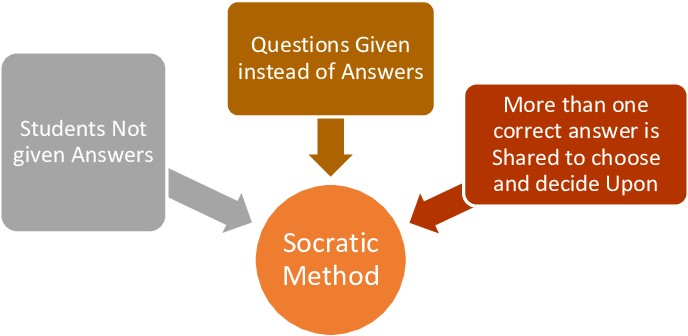
Discover the Socratic Method: A Dynamic Teaching Tool
The Socratic Method, an age-old teaching technique rooted in the works of the Greek philosopher Socrates, is not just an educational relic but a dynamic classroom strategy that invigorates student engagement.
Imagine a classroom where every student is not merely absorbing information but actively questioning and exploring ideas with curiosity. This method thrives on asking and answering questions, encouraging students to develop profound insights into their subjects.
It challenges assumptions, promotes critical thinking, and fosters an environment of lively debate. Whether teaching at the elementary level or within the halls of higher education, the Socratic Method unlocks the potential for students to own their learning journey.
Let’s dive in to learn how you can embrace this powerful tool and transform your classroom into a hub of intellectual discovery!
Before you move to the topic, can we ask you a quick question? Do you follow us on Social Media? If not, then you’re missing out on a lot of informative content. We regularly share upgraded educational content, tips, feedback, and more. Check us out by clicking the profiles here - Facebook / Twitter / LinkedIn / Pinterest / Instagram / YouTube
Understanding the Socratic Method
Let’s gain a proper understanding of the Socratic teaching method:
Origins and Philosophy of the Socratic Method

The Socratic Method, a cornerstone of Western philosophy, traces its roots back to the ancient Greek philosopher Socrates. Renowned for engaging in dialogues that sought truth through relentless questioning, Socrates believed that this method could promote intelligence and virtue. By systematically asking and answering questions, participants are encouraged to think critically and explore the boundaries of their perspectives.
This technique is not limited by subject or level. From elementary classrooms to university lecture halls, the Socratic Method invites learners to challenge their assumptions and engage with content more deeply than through traditional rote memorization.
The Role of Questioning in Stimulating Critical Thinking
Questioning is at the heart of the Socratic Method and plays a vital role in stimulating critical thinking. Instead of providing direct answers, instructors use probing questions to help students reflect on their assumptions and evaluate underlying beliefs. This approach compels students to develop their reasoning skills and engage with the material in a meaningful way.
By fostering an environment where thoughtful questioning is encouraged, educators can help students navigate complex issues, negotiate differing viewpoints, and ultimately gain a more profound and nuanced understanding of the subject matter.
Tips for Using the Socratic Method
Let’s get to know some of the effective tips for implementing the Socratic teaching method:
>> Initiating Discussions with Thought-Provoking Questions
The magic of the Socratic Method begins with the right question. It's the spark that ignites curiosity and fuels a dynamic learning atmosphere. Start with questions that encourage students to think deeply and avoid those that yield simple yes or no answers.
For instance, instead of asking, "Is climate change real?", pose a question like, "What are the primary factors driving climate change and how do they affect our daily lives?" This kind of questioning propels students into a realm of critical thinking, prompting them to explore and dissect ideas.
>> Encouraging Student Questioning and Critical Analysis
Encouragement is key to opening the floodgates of dialogue in the classroom. Invite students to challenge assumptions and propose their questions, creating a robust platform for critical analysis. This process not only hones their analytical skills but also helps illuminate areas of confusion or misunderstanding, thus fostering a deeper engagement with the material.
>> Balancing Guidance with Student-Led Inquiry
The role of a teacher in a Socratic dialogue is akin to a gentle guide, steering the conversation without dominating it. Strive to strike a balance between providing direction and allowing students to take charge of their inquiries. Encourage brainstorming and exploration, gently nudging them back on track when discussions veer off course, ensuring that learning remains student-focused and exploratory.
Benefits of the Socratic Method
Let’s get to know some of the most crucial benefits of implementing the Socratic teaching method:
>> Developing a Deeper Understanding of the Subject Matter
One of the most profound benefits of the Socratic Method is its ability to deepen students' understanding of the subject matter. By engaging in dialogue, students are not just learning facts; they are unraveling the intricate tapestry of ideas and concepts. This exploration allows students to dissect and examine their preconceptions and gain a comprehensive grasp of the topic.
>> Promoting Active and Engaged Learning
Incorporating the Socratic Method transforms passive learning into an active pursuit of knowledge. Students become participants rather than spectators in their educational journey, encouraged to engage with content, challenge perspectives, and construct their own understanding. This active involvement nurtures a contagious enthusiasm for learning, keeping students invested and attentive.
>> Fostering a Collaborative and Respectful Classroom Environment
The respect fostered through the Socratic Method is palpable. By promoting active listening and consideration of diverse viewpoints, this method builds a classroom culture founded on mutual respect and collaboration. Students learn to value differing opinions and work together towards collective understanding, ultimately creating an environment where every voice is heard, valued, and appreciated.
Challenges in Using the Socratic Method
The Socratic Method, though powerful, is not without its challenges. A primary obstacle is that it can be time-consuming. Unlike traditional teaching methods where information flows in a straightforward, one-way direction, the Socratic Method relies on dialogue, which requires substantial time to allow meaningful reflection and exchange of ideas.
Teachers might also find it difficult if they are accustomed to a faster-paced teaching style, and students may struggle to adjust to its demands, especially if they are used to passive learning.
>> Overcoming Time Constraints in the Classroom
To effectively incorporate the Socratic Method within limited class time, structure and planning are essential. Teachers can prepare by creating a focused list of questions that guide the discussion without shifting to unrelated tangents. It is important to prioritize key concepts that align with the learning objectives and encourage concise but thoughtful student responses.
Additionally, teachers can set clear time limits for each question, ensuring each student contributes without bogging down the discussion. By adopting a more agile approach, classrooms can harness the benefits of deep inquiry amid tight schedules.
>> Addressing Student Frustration with the Inquiry Process
For students accustomed to lectures and straightforward answers, the shift to an inquiry-based format might be frustrating. They could feel overwhelmed when having to think independently and articulate their ideas. To mitigate this, teachers should foster a supportive environment where students understand that struggling is part of the learning process. Initially, guiding students through examples of Socratic dialogue can build their confidence.
Teachers should reassure students that not knowing an answer immediately is an opportunity to develop their critical thinking and problem-solving skills. By emphasizing the value of exploration over immediate answers, students gradually become more comfortable and engaged.
>> Transitioning from Traditional Teaching Styles
Transitioning from traditional to Socratic teaching styles can be daunting for educators who are comfortable with established methods. However, embracing this shift brings diverse learning opportunities. Educators should start by blending Socratic questioning with their current practices. For example, dedicating specific segments of a lesson to Socratic debate allows teachers and students to adjust gradually.
Professional development workshops focusing on the Socratic Method can provide valuable insights and techniques. By embracing continuous learning and experimentation, teachers can transform their classrooms into vibrant spaces where inquiry and dialogue foster a deep, enduring passion for learning.
Final Thoughts on the Socratic Method
The Socratic Method is transformative, not just in prompting critical thinking but in reshaping the classroom into a dynamic space of exploration and discovery. Passionate engagement, deep inquiry, and respectful dialogue are the hallmarks that the Socratic Method brings. By regularly employing open-ended questions and fostering an environment where all voices are encouraged, educators can stimulate students to move beyond memorization, paving the way for genuine understanding and application of knowledge in real-life scenarios.
As educators, doing justice to this method means providing students the chance to explore their thoughts, challenge assumptions, and grow into individuals who are curious and critically engaged with the world around them. So, let the power of questions and pursuing courses like the Online Master of Arts in Teaching elevate your teaching, take the step to incorporate the Socratic Method into your classroom today!
We believe education should be accessible for everyone. That’s why we don’t charge for our blogs. Find the right course that will help you in your career with us, contact us at +66-21055721. You can mail us at act@asiancollegeofteachers.com

